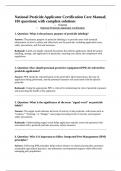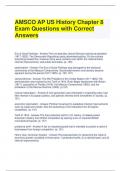National Pesticide Applicator Certification Core Manual|
105 questions| with complete solutions
Course
National Pesticide Applicator Certification
1. Question: What is the primary purpose of pesticide labeling?
Answer: The primary purpose of pesticide labeling is to provide users with essential
information on how to safely and effectively use the pesticide, including application rates,
safety precautions, and first aid measures.
Rationale: Labels are legally required documents that inform applicators about the proper
handling, storage, and application of pesticides, ensuring user safety and compliance with
regulations.
2. Question: How should personal protective equipment (PPE) be selected for
pesticide application?
Answer: PPE should be selected based on the pesticide's label instructions, the type of
application being performed, and the potential exposure risk associated with the specific
pesticide.
Rationale: Using the appropriate PPE is critical for minimizing the risk of pesticide exposure
and protecting the health of the applicator.
3. Question: What is the significance of the term "signal word" on pesticide
labels?
Answer: The signal word indicates the level of toxicity of the pesticide, with terms such as
"Caution," "Warning," or "Danger" conveying increasing levels of toxicity and required
safety precautions.
Rationale: Understanding signal words helps applicators quickly assess the potential risks
associated with a pesticide and take necessary safety measures.
4. Question: Why is it important to follow Integrated Pest Management (IPM)
principles?
Answer: Following IPM principles helps reduce reliance on chemical pesticides, promotes
sustainable agricultural practices, and minimizes environmental impacts while effectively
managing pest populations.
,Rationale: IPM is a holistic approach that combines multiple strategies to control pests
sustainably and reduce potential negative consequences of pesticide use.
5. Question: What is the proper procedure for calibrating pesticide
application equipment?
Answer: The proper procedure involves measuring the output of the application equipment
under normal operating conditions, calculating the application rate, and adjusting the
equipment as necessary to achieve the desired rate.
Rationale: Calibration ensures accurate and consistent application of pesticides, reducing the
risk of under- or over-application, which can lead to ineffective pest control or environmental
harm.
6. Question: What should be done in the event of a pesticide spill?
Answer: In the event of a pesticide spill, the applicator should immediately follow the
emergency response procedures outlined on the pesticide label, which may include containing
the spill, evacuating the area, and notifying authorities.
Rationale: Prompt and proper response to spills minimizes risks to human health and the
environment, ensuring compliance with safety regulations.
7. Question: How does soil type affect pesticide application?
Answer: Soil type influences the adsorption, mobility, and degradation of pesticides; sandy
soils may allow for quicker movement of pesticides, while clay soils may retain them longer.
Rationale: Understanding soil characteristics helps applicators predict pesticide behavior in
the environment, allowing for better management decisions and minimizing runoff.
8. Question: What is the importance of pesticide disposal regulations?
Answer: Pesticide disposal regulations are designed to prevent environmental contamination
and protect human health by ensuring that pesticide waste is managed safely and
appropriately.
Rationale: Complying with disposal regulations is essential for preventing harmful effects on
ecosystems and adhering to legal requirements.
,9. Question: What factors can contribute to pesticide drift?
Answer: Factors contributing to pesticide drift include wind speed and direction, temperature
inversions, droplet size, and the application method used.
Rationale: Understanding drift dynamics helps applicators choose appropriate application
times and methods to minimize off-target movement of pesticides.
10. Question: What is the role of a Material Safety Data Sheet (MSDS) in
pesticide safety?
Answer: An MSDS provides detailed information on the chemical properties, hazards, safe
handling, and emergency response measures associated with a specific pesticide.
Rationale: Access to MSDS information is vital for understanding the risks of handling
pesticides and ensuring proper safety precautions are taken.
11. Question: What is the definition of "pesticide"?
Answer: A pesticide is any substance or mixture of substances intended for preventing,
destroying, repelling, or mitigating any pest, including insects, weeds, fungi, and
microorganisms.
Rationale: Understanding the definition of pesticides is essential for knowing what products
fall under regulatory guidelines and safety practices.
12. Question: What factors should be considered when planning a pesticide
application?
Answer: Factors to consider include the target pest, weather conditions, time of day, the life
cycle of the pest, and any nearby sensitive areas such as water bodies or wildlife habitats.
Rationale: Proper planning helps ensure the effectiveness of the application while
minimizing risks to non-target organisms and the environment.
13. Question: What is the purpose of buffer zones in pesticide applications?
Answer: Buffer zones are areas left untreated with pesticides to minimize the risk of
pesticide drift and protect nearby sensitive areas, such as water bodies and non-target
habitats.
Rationale: Establishing buffer zones is crucial for reducing the environmental impact of
pesticide applications and ensuring compliance with regulatory requirements.
, 14. Question: What is meant by "resistance management" in pest control?
Answer: Resistance management refers to strategies designed to prevent or delay the
development of resistance in pest populations, ensuring that pesticides remain effective over
time.
Rationale: Implementing resistance management practices is critical for sustaining the
efficacy of pest control measures and reducing the need for more toxic alternatives.
15. Question: How can you determine if a pesticide has high environmental
persistence?
Answer: Environmental persistence can be determined by reviewing the pesticide's half-life
data, which indicates how long it remains active in the environment before breaking down.
Rationale: Understanding a pesticide's persistence helps applicators make informed
decisions about its potential impact on soil and water quality.
16. Question: What is the difference between "target pests" and "non-target
organisms"?
Answer: Target pests are the specific pests intended to be controlled by a pesticide, while
non-target organisms are other living entities that may be affected by the pesticide but are not
the intended targets.
Rationale: Differentiating between these groups is essential for ensuring that pest
management practices are effective while minimizing harm to beneficial organisms.
17. Question: What is the purpose of proper pesticide storage?
Answer: Proper pesticide storage prevents leaks, spills, and contamination, ensures the
effectiveness of the products, and minimizes the risk of accidental exposure or misuse.
Rationale: Safe storage practices are crucial for protecting human health and the
environment, as well as complying with legal regulations.
18. Question: Why is it important to maintain accurate application records?





